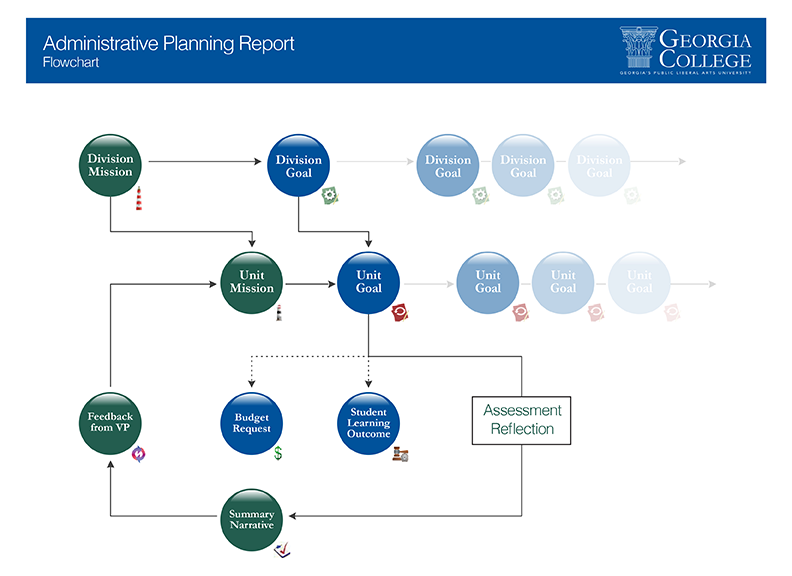Administrative Planning and Assessment

Each administrative unit head completes an Administrative Planning Report annually. For the Administrative Planning process, all administrative units articulate goals and objectives that align with GCSU's mission and strategic directions, measure outcomes on a regular basis in multiple ways, analyze the findings, and describe how findings are used for improvements. These are submitted to the senior administrator responsible for each division. Once submitted, each unit receives feedback from the appropriate Vice President. Annual Administrative Planning reports are submitted and housed in Taskstream!.
Administrative Planning Report template.
Elements of Administrative Planning Reports:
I) Annual Assessment Summary (optional)
Examples include the following:
-The Office of Admissions set a goal to enroll a diverse freshmen class of 1300 students for the Fall of 2012. They subsequently recruited and admitted the largest freshmen class in the university's history. The Fall 2013 freshmen class consists of 1391 confirmed students. The class includes 187 minority students, 7 out of state students, and 225 high ability students; the number of students in each of these populations increased from last year's entering freshmen class. In addition, the Fall 2013 entering class has the highest academic credentials of any class admitted to the University, with an average high school GPA of 3.45 (+.02 from last year) and an average SAT score of 1164 (+3 from last year).
-The Student Account Center's direct deposit marketing helped to increase the number of students enrolled in direct deposit by 10% from FY12. This boosted total student participation to 80%. This demonstrated an increase in the number of students enrolled in direct deposit for three years in a row (FY11, FY12, FY13). This increase is desirable in that direct deposit is more cost effective, efficient, and more convenient for students.
-The Bridge Scholars Program set two outcomes for FY13 and exceeded both. They were interested in (1) successfully transitioning 90% or greater of the summer cohort of scholars to regularly admitted students for the Fall and (2) maintaining retention rates of scholars at rates higher than that of the University's for the same population of students (new freshmen). Ninety-eight (98)% of the students who participated in the program in Summer 2012 returned and enrolled for the Fall 2012 semester. Data also demonstrated that students who participated in the Bridge Scholars Program continued to be retained at a level slightly higher than their comparable freshmen cohorts. The 2011 BSP cohort had the highest Y1:Y2 retention in the history of the program - 91.51%. This rate was 7.84% higher than that of the 2010 cohort and 5.74% higher than the university's Y1:Y2 rate.
II) Mission
The mission statement that is unique to the unit/division that maps to university strategic directions and mission.III) Goals and Objectives
IV) Results
V) Interpretation of Results
Based the question, "Do the results indicate that this outcome was met?"...
If NO: If no, why do you think results were not met?
Example:New software was never implemented, weekly reports were not generated, trainings were not well attended, survey was never sent out (or low response rate), not enough support staff, service was not offered consistently, etc...
VI) Next Steps
Based on that analysis, what changes will be made during the next assessment cycle for improvement in your department (to operations, student services, student experience, etc...)?
Example: Provide additional training sessions, make trainings mandatory, hire a student support personnel to address xxx gap, extend hours of operation, include orientation during Week of Welcome, adopt new software solution, update technology xxx, etc...
or
YES: If results indicate that you did meet this goal, what are your next steps regarding this goal?
Example: Will you continue to use 'as is' to monitor results and impact longitudinally? Will you increase or decrease targets? Why? Will you add another means to assess the goal? (Etc...)
Feedback is provided annually to each administrative unit by the Vice President of the respective division and is also housed in Taskstream! This process allows for division Vice Presidents to critically examine the effectiveness of each administrative unit and allows for specific and targeted feedback that units use to improve performance and to increase the overall effectiveness of the university, in support of its mission and strategic plan.